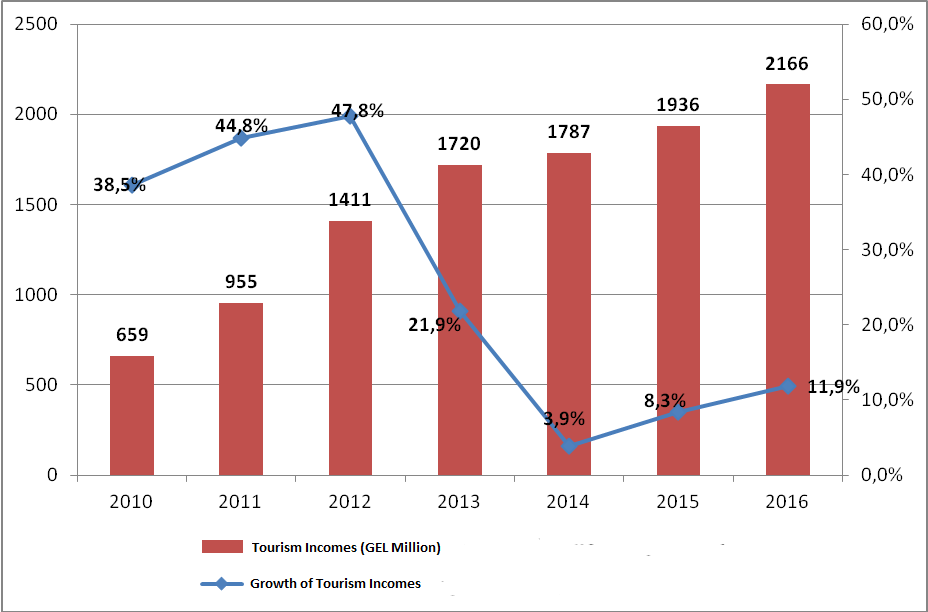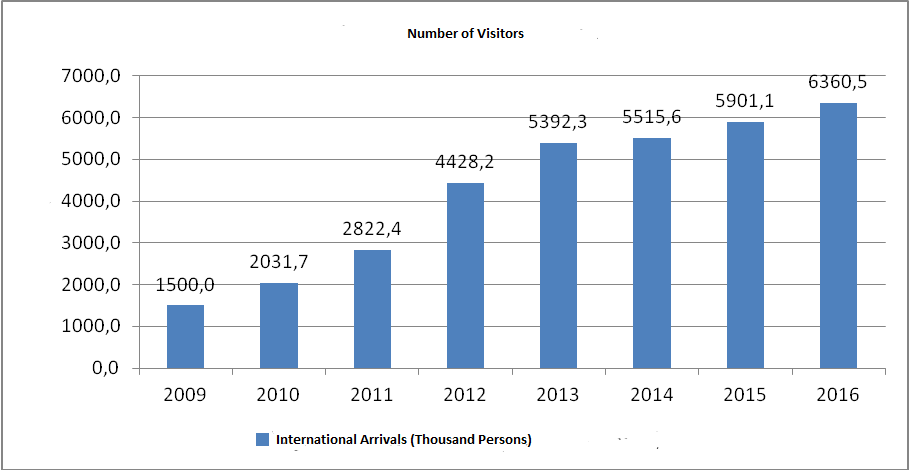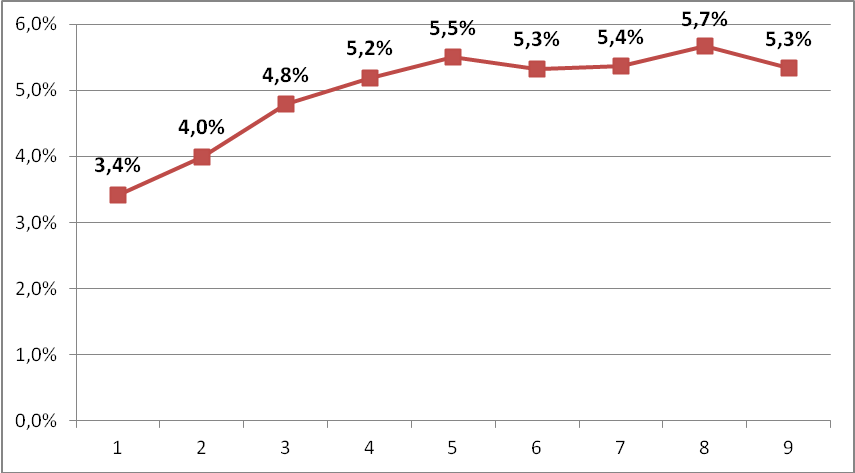On 29 November 2017, the Minister of Economy and Sustainable Development, Dimitri Kumsishvili, in his speech at the Tbilisi Silk Road Forum spoke about the development of Georgia’s tourism sector. The Minister stated that tourism revenues will exceed USD 2 billion by the end of this year.
FactCheck verified the accuracy of the statement.
Since 2009, tourism has been one of the most rapidly growing sectors of Georgia’s economy. In the period of 2009-2012, both the number of visitors and tourism incomes increased substantially. The situation has radically changed since 2012 when tourism’s income growth rate became slower with the lowest growth rate registered in 2014, largely stipulated by the imposition of the then new visa regulations. In 2014 Georgia abolished its visa-free regime with 24 countries which in turn affected the number of visitors to the country as well as tourism incomes.
One year after its imposition of strict visa regulations, the Government of Georgia admitted its mistake and simplified visa regulations to mitigate the negative consequences of the strict visa regime. This decision was reflected in the tourism sector in the very same year and tourism incomes started to increase again. In 2015, tourism incomes increased by 8.3% and constituted USD 1.9 billion whilst tourism incomes in 2016 reached USD 2.2 billion which was 11.9% more as compared to the same figure of the previous year.
Graph 1: Tourism Incomes in 2010-2016
 Source: National Bank of Georgia, Georgian National Tourism Administration
According to the data of the National Bank of Georgia, Georgia received USD 1.1 billion from tourism as of the first two quarters of 2017 which is 26% more as compared to the same figure of the previous year. In regard to tourism incomes in summer where the tourism revenues are their highest, respective figures are currently not available. However, considering the fact that tourism incomes are directly related to the number of visitors to the country, it is possible to calculate tourism incomes based on the number of international visitors coming to Georgia.
Graph 2: Number of Visitors to Georgia in 2009-2016
Source: National Bank of Georgia, Georgian National Tourism Administration
According to the data of the National Bank of Georgia, Georgia received USD 1.1 billion from tourism as of the first two quarters of 2017 which is 26% more as compared to the same figure of the previous year. In regard to tourism incomes in summer where the tourism revenues are their highest, respective figures are currently not available. However, considering the fact that tourism incomes are directly related to the number of visitors to the country, it is possible to calculate tourism incomes based on the number of international visitors coming to Georgia.
Graph 2: Number of Visitors to Georgia in 2009-2016
 Source: National Bank of Georgia, Georgian National Tourism Administration
According to the Georgian National Tourism Administration, the number of international visitors was 6,955,000 persons in January to November of this year which is 18% more as compared to the same figure of the previous year. Of the total number of international visitors, the share of tourists is 46.6% (3,244,000 persons). In the January-November period, the amount of tourists coming to Georgia increased by 701,000 (26.1%) persons.
Based on the statisical data, the average amount of money spent by one visitor in Georgia was USD 340 in 2016. Therefore, if we multiply the number of visitors by the average amount of money spent, we can obtain a good understanding of tourism incomes in the January-November period. As there were 6,954,000 international visitors to the country, the amount of tourism incomes from that period should be approximately USD 2.4 billion.
Tourism incomes can also be calculated on the basis of the growth in the number of visitors. The visitor growth rate and that of tourism income are close. According to November’s figures, the amount of visitors to the country increased by 18%. Therefore, the growth in tourism incomes should be within the margin of this figure. In 2016, tourism incomes amounted to GEL 2.2 billion; therefore, the amount of tourism income this year should be approximately USD 2.5 billion as a result of the 18% growth.
Tourism sector development also affects the amount of employees in this business field. In the period of 2010-2016, tourism’s share in Georgia’s economy has grown from 6.8% to 7.2%. At the same time, the number of employees in this sector has increased as well.
Graph 3: Share of Employees in the Tourism Sector
Source: National Bank of Georgia, Georgian National Tourism Administration
According to the Georgian National Tourism Administration, the number of international visitors was 6,955,000 persons in January to November of this year which is 18% more as compared to the same figure of the previous year. Of the total number of international visitors, the share of tourists is 46.6% (3,244,000 persons). In the January-November period, the amount of tourists coming to Georgia increased by 701,000 (26.1%) persons.
Based on the statisical data, the average amount of money spent by one visitor in Georgia was USD 340 in 2016. Therefore, if we multiply the number of visitors by the average amount of money spent, we can obtain a good understanding of tourism incomes in the January-November period. As there were 6,954,000 international visitors to the country, the amount of tourism incomes from that period should be approximately USD 2.4 billion.
Tourism incomes can also be calculated on the basis of the growth in the number of visitors. The visitor growth rate and that of tourism income are close. According to November’s figures, the amount of visitors to the country increased by 18%. Therefore, the growth in tourism incomes should be within the margin of this figure. In 2016, tourism incomes amounted to GEL 2.2 billion; therefore, the amount of tourism income this year should be approximately USD 2.5 billion as a result of the 18% growth.
Tourism sector development also affects the amount of employees in this business field. In the period of 2010-2016, tourism’s share in Georgia’s economy has grown from 6.8% to 7.2%. At the same time, the number of employees in this sector has increased as well.
Graph 3: Share of Employees in the Tourism Sector
 Source: National Statistics Office of Georgia
According to the data of the National Statistics Office of Georgia, the number of employees in the hotel and restaurant industry has doubled in the last five years whilst the share of employees in this sector has increased from 3.4% to 5.3% in the total number of employment. As of the third quarter of 2017, the total number of hired employees in hotels and restaurants constitutes 32,570 persons. Additionally, we have to take into account that the tourism sector includes not only hotels and restaurants but also tour operators, transport companies and other services. Therefore, we can conclude that the number of employees in the tourism sector is much higher.
Conclusion
In 2017, the amount of international visitors increased by 18% as compared to the previous years whilst the data of the first two quarters of this year show that the amount of tourism incomes has increased by 26% as compared to the same period of the previous year. If we take into account the fact that the tourism income growth rate coincides with the growth rate of international visitors to Georgia whilst considering the average amount of money spent by one visitor, we can conclude that the amount of tourism income significantly exceeds USD 2 billion this year.
FactCheck will come back to this issue in the future. At this stage we conclude that Dimitri Kumsishvili’s statement is TRUE.
Source: National Statistics Office of Georgia
According to the data of the National Statistics Office of Georgia, the number of employees in the hotel and restaurant industry has doubled in the last five years whilst the share of employees in this sector has increased from 3.4% to 5.3% in the total number of employment. As of the third quarter of 2017, the total number of hired employees in hotels and restaurants constitutes 32,570 persons. Additionally, we have to take into account that the tourism sector includes not only hotels and restaurants but also tour operators, transport companies and other services. Therefore, we can conclude that the number of employees in the tourism sector is much higher.
Conclusion
In 2017, the amount of international visitors increased by 18% as compared to the previous years whilst the data of the first two quarters of this year show that the amount of tourism incomes has increased by 26% as compared to the same period of the previous year. If we take into account the fact that the tourism income growth rate coincides with the growth rate of international visitors to Georgia whilst considering the average amount of money spent by one visitor, we can conclude that the amount of tourism income significantly exceeds USD 2 billion this year.
FactCheck will come back to this issue in the future. At this stage we conclude that Dimitri Kumsishvili’s statement is TRUE.
 Source: National Bank of Georgia, Georgian National Tourism Administration
According to the data of the National Bank of Georgia, Georgia received USD 1.1 billion from tourism as of the first two quarters of 2017 which is 26% more as compared to the same figure of the previous year. In regard to tourism incomes in summer where the tourism revenues are their highest, respective figures are currently not available. However, considering the fact that tourism incomes are directly related to the number of visitors to the country, it is possible to calculate tourism incomes based on the number of international visitors coming to Georgia.
Graph 2: Number of Visitors to Georgia in 2009-2016
Source: National Bank of Georgia, Georgian National Tourism Administration
According to the data of the National Bank of Georgia, Georgia received USD 1.1 billion from tourism as of the first two quarters of 2017 which is 26% more as compared to the same figure of the previous year. In regard to tourism incomes in summer where the tourism revenues are their highest, respective figures are currently not available. However, considering the fact that tourism incomes are directly related to the number of visitors to the country, it is possible to calculate tourism incomes based on the number of international visitors coming to Georgia.
Graph 2: Number of Visitors to Georgia in 2009-2016
 Source: National Bank of Georgia, Georgian National Tourism Administration
According to the Georgian National Tourism Administration, the number of international visitors was 6,955,000 persons in January to November of this year which is 18% more as compared to the same figure of the previous year. Of the total number of international visitors, the share of tourists is 46.6% (3,244,000 persons). In the January-November period, the amount of tourists coming to Georgia increased by 701,000 (26.1%) persons.
Based on the statisical data, the average amount of money spent by one visitor in Georgia was USD 340 in 2016. Therefore, if we multiply the number of visitors by the average amount of money spent, we can obtain a good understanding of tourism incomes in the January-November period. As there were 6,954,000 international visitors to the country, the amount of tourism incomes from that period should be approximately USD 2.4 billion.
Tourism incomes can also be calculated on the basis of the growth in the number of visitors. The visitor growth rate and that of tourism income are close. According to November’s figures, the amount of visitors to the country increased by 18%. Therefore, the growth in tourism incomes should be within the margin of this figure. In 2016, tourism incomes amounted to GEL 2.2 billion; therefore, the amount of tourism income this year should be approximately USD 2.5 billion as a result of the 18% growth.
Tourism sector development also affects the amount of employees in this business field. In the period of 2010-2016, tourism’s share in Georgia’s economy has grown from 6.8% to 7.2%. At the same time, the number of employees in this sector has increased as well.
Graph 3: Share of Employees in the Tourism Sector
Source: National Bank of Georgia, Georgian National Tourism Administration
According to the Georgian National Tourism Administration, the number of international visitors was 6,955,000 persons in January to November of this year which is 18% more as compared to the same figure of the previous year. Of the total number of international visitors, the share of tourists is 46.6% (3,244,000 persons). In the January-November period, the amount of tourists coming to Georgia increased by 701,000 (26.1%) persons.
Based on the statisical data, the average amount of money spent by one visitor in Georgia was USD 340 in 2016. Therefore, if we multiply the number of visitors by the average amount of money spent, we can obtain a good understanding of tourism incomes in the January-November period. As there were 6,954,000 international visitors to the country, the amount of tourism incomes from that period should be approximately USD 2.4 billion.
Tourism incomes can also be calculated on the basis of the growth in the number of visitors. The visitor growth rate and that of tourism income are close. According to November’s figures, the amount of visitors to the country increased by 18%. Therefore, the growth in tourism incomes should be within the margin of this figure. In 2016, tourism incomes amounted to GEL 2.2 billion; therefore, the amount of tourism income this year should be approximately USD 2.5 billion as a result of the 18% growth.
Tourism sector development also affects the amount of employees in this business field. In the period of 2010-2016, tourism’s share in Georgia’s economy has grown from 6.8% to 7.2%. At the same time, the number of employees in this sector has increased as well.
Graph 3: Share of Employees in the Tourism Sector
 Source: National Statistics Office of Georgia
According to the data of the National Statistics Office of Georgia, the number of employees in the hotel and restaurant industry has doubled in the last five years whilst the share of employees in this sector has increased from 3.4% to 5.3% in the total number of employment. As of the third quarter of 2017, the total number of hired employees in hotels and restaurants constitutes 32,570 persons. Additionally, we have to take into account that the tourism sector includes not only hotels and restaurants but also tour operators, transport companies and other services. Therefore, we can conclude that the number of employees in the tourism sector is much higher.
Conclusion
In 2017, the amount of international visitors increased by 18% as compared to the previous years whilst the data of the first two quarters of this year show that the amount of tourism incomes has increased by 26% as compared to the same period of the previous year. If we take into account the fact that the tourism income growth rate coincides with the growth rate of international visitors to Georgia whilst considering the average amount of money spent by one visitor, we can conclude that the amount of tourism income significantly exceeds USD 2 billion this year.
FactCheck will come back to this issue in the future. At this stage we conclude that Dimitri Kumsishvili’s statement is TRUE.
Source: National Statistics Office of Georgia
According to the data of the National Statistics Office of Georgia, the number of employees in the hotel and restaurant industry has doubled in the last five years whilst the share of employees in this sector has increased from 3.4% to 5.3% in the total number of employment. As of the third quarter of 2017, the total number of hired employees in hotels and restaurants constitutes 32,570 persons. Additionally, we have to take into account that the tourism sector includes not only hotels and restaurants but also tour operators, transport companies and other services. Therefore, we can conclude that the number of employees in the tourism sector is much higher.
Conclusion
In 2017, the amount of international visitors increased by 18% as compared to the previous years whilst the data of the first two quarters of this year show that the amount of tourism incomes has increased by 26% as compared to the same period of the previous year. If we take into account the fact that the tourism income growth rate coincides with the growth rate of international visitors to Georgia whilst considering the average amount of money spent by one visitor, we can conclude that the amount of tourism income significantly exceeds USD 2 billion this year.
FactCheck will come back to this issue in the future. At this stage we conclude that Dimitri Kumsishvili’s statement is TRUE.
Tags:







